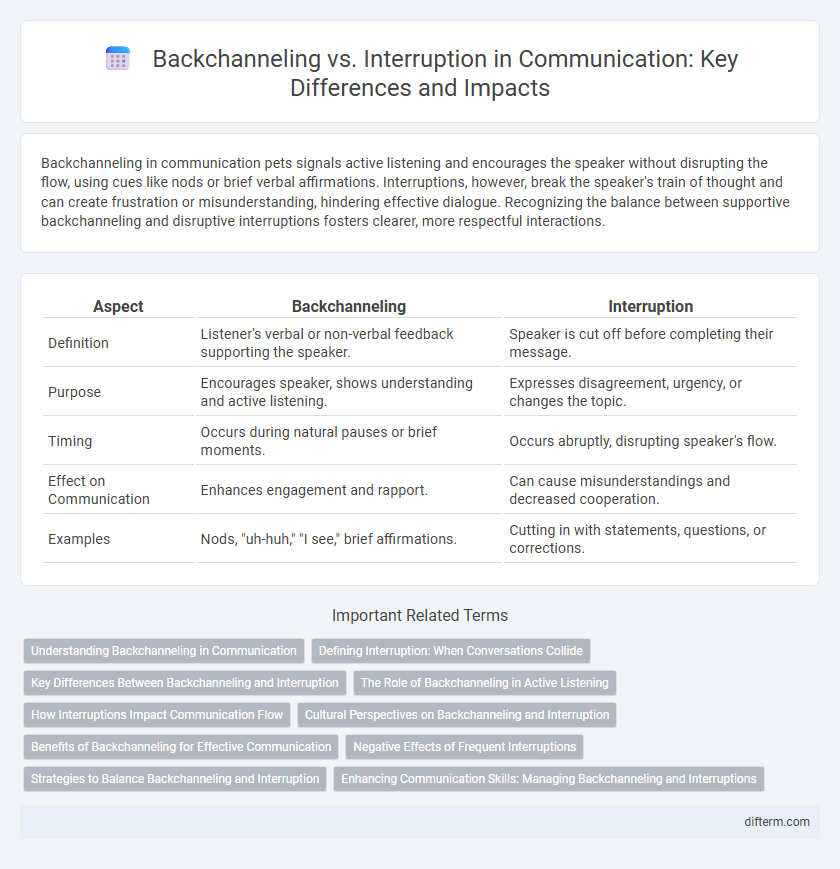Backchanneling in communication pets signals active listening and encourages the speaker without disrupting the flow, using cues like nods or brief verbal affirmations. Interruptions, however, break the speaker's train of thought and can create frustration or misunderstanding, hindering effective dialogue. Recognizing the balance between supportive backchanneling and disruptive interruptions fosters clearer, more respectful interactions.
Table of Comparison
| Aspect | Backchanneling | Interruption |
|---|---|---|
| Definition | Listener's verbal or non-verbal feedback supporting the speaker. | Speaker is cut off before completing their message. |
| Purpose | Encourages speaker, shows understanding and active listening. | Expresses disagreement, urgency, or changes the topic. |
| Timing | Occurs during natural pauses or brief moments. | Occurs abruptly, disrupting speaker's flow. |
| Effect on Communication | Enhances engagement and rapport. | Can cause misunderstandings and decreased cooperation. |
| Examples | Nods, "uh-huh," "I see," brief affirmations. | Cutting in with statements, questions, or corrections. |
Understanding Backchanneling in Communication
Backchanneling in communication involves subtle listener responses, such as nodding or brief verbal affirmations like "uh-huh," which signal attention and encourage the speaker to continue. Unlike interruptions that disrupt the speaker's flow, backchanneling maintains conversational harmony by providing non-intrusive feedback. Effective backchanneling enhances understanding and engagement, fostering smoother and more interactive dialogues.
Defining Interruption: When Conversations Collide
Interruption occurs when one speaker's turn is cut short by another, disrupting the natural flow of conversation and often conveying impatience or dominance. Unlike backchanneling, which signals active listening through brief verbal or nonverbal cues, interruptions shift the speaker role prematurely and can hinder mutual understanding. Recognizing the distinction between supportive backchanneling and disruptive interruption is crucial for effective communication and preserving conversational harmony.
Key Differences Between Backchanneling and Interruption
Backchanneling involves brief verbal or nonverbal cues, such as nodding or saying "uh-huh," to show active listening without disrupting the speaker's flow, while interruption occurs when a listener breaks the speaker's continuity by interjecting their own thoughts prematurely. Backchanneling enhances communication by signaling engagement and understanding, whereas interruptions can hinder effective dialogue and cause frustration. The key difference lies in backchanneling supporting speaker expression, whereas interruptions disrupt and redirect conversation.
The Role of Backchanneling in Active Listening
Backchanneling plays a crucial role in active listening by signaling engagement and understanding without disrupting the speaker's flow. Unlike interruptions, backchannel cues such as nodding, verbal affirmations, and brief responses help maintain the conversational rhythm and encourage the speaker to continue. Effective backchanneling enhances communication by fostering rapport and validating the speaker's message.
How Interruptions Impact Communication Flow
Interruptions disrupt communication flow by breaking the speaker's train of thought and causing misunderstandings or frustration. Unlike backchanneling, which provides supportive cues without taking over the conversation, interruptions often signal dominance or impatience, hindering effective dialogue. Research shows frequent interruptions correlate with reduced information retention and weakened conversational rapport.
Cultural Perspectives on Backchanneling and Interruption
Cultural perspectives on backchanneling and interruption reveal significant variation in communication norms, where backchanneling such as nodding or brief verbal affirmations is valued as a sign of active listening in many Eastern and Latin American cultures. In contrast, interruption patterns vary widely; in some Western cultures, interruptions might be seen as engagement and enthusiasm, while in others, they are viewed as disrespectful. Understanding these cultural differences is essential for effective cross-cultural communication and avoiding misunderstandings in international or multicultural interactions.
Benefits of Backchanneling for Effective Communication
Backchanneling fosters active listening by providing verbal and non-verbal cues that encourage speakers to continue, enhancing engagement and comprehension. This supportive feedback helps clarify meaning, builds rapport, and reduces misunderstandings in conversations. Employing backchanneling techniques leads to smoother interactions and more effective communication outcomes compared to interruptions that disrupt the speaker's flow.
Negative Effects of Frequent Interruptions
Frequent interruptions disrupt the flow of communication, leading to misunderstandings and reduced message clarity. They increase speaker frustration and hinder active listening, which weakens overall conversational engagement. Persistent interruptions can damage relationships by signaling disrespect and devaluing the speaker's contribution.
Strategies to Balance Backchanneling and Interruption
Effective communication requires strategic management of backchanneling and interruption to maintain dialogue flow and mutual understanding. Employing active listening cues such as nodding or brief verbal affirmations signals engagement without disrupting the speaker, while setting clear turn-taking protocols reduces unintentional interruptions. Training in conversational awareness encourages speakers to recognize and respond appropriately to backchanneling, fostering a balanced interaction dynamic.
Enhancing Communication Skills: Managing Backchanneling and Interruptions
Effective communication requires balancing backchanneling and interruptions to foster engagement without disrupting the speaker's flow. Backchanneling signals active listening through brief verbal affirmations or nonverbal cues, enhancing rapport and understanding. Managing interruptions involves recognizing appropriate timing and intent, ensuring conversations remain respectful and collaborative while addressing essential points.
backchanneling vs interruption Infographic

 difterm.com
difterm.com